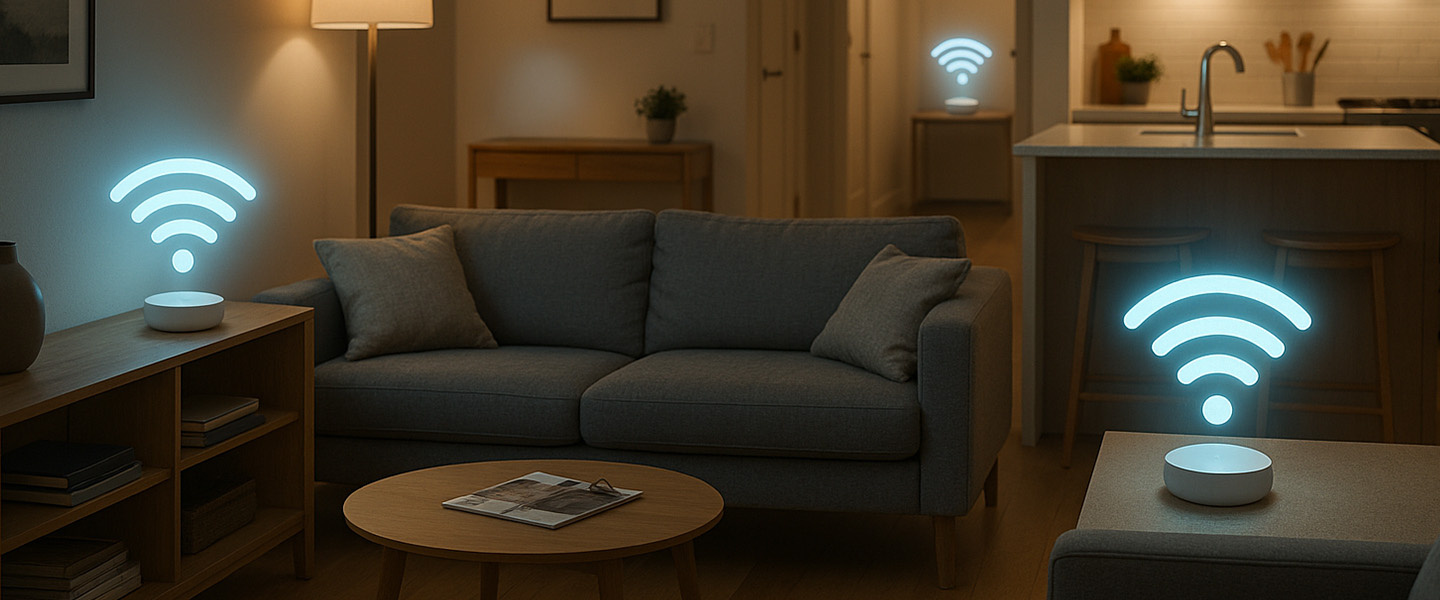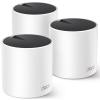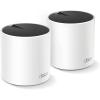What Is Mesh Wi-Fi, and do you need it in your home?
Buffering in the bedroom? Signal dropping in the kitchen? If your home Wi-Fi feels patchy or inconsistent, you’re not alone, and there’s a reason for it.
Most households today are packed with connected devices, but many are still running on a single router that simply can’t cover every corner. That’s where mesh Wi-Fi comes in.
In this guide, we’ll break down what mesh Wi-Fi actually is, how it works, and whether it’s the right upgrade for your home.
What Exactly Is Mesh Wi-Fi?
A mesh Wi-Fi system replaces your standard router with a group of wireless nodes, usually called a router and satellites. These work together to provide consistent Wi-Fi coverage across your entire home.
Instead of relying on a single point to broadcast a signal, each node in the system acts like a mini-router. They communicate with each other to share your internet connection and extend coverage to hard-to-reach areas like upstairs bedrooms, garages, or corners where your signal usually dies.
Think of it like this: instead of shouting from the lounge and hoping the kids hear you upstairs, mesh Wi-Fi puts a helper in every room to pass the message along clearly and quickly.
How Is It Different from a Range Extender?
Range extenders (or boosters) are a band-aid solution. They take your existing Wi-Fi signal and rebroadcast it, often creating a new network name that you have to manually switch to when moving through the house. The signal is weaker, and the transition is rarely seamless.
Mesh systems, by contrast:
- Use a single network name across your home
- Automatically connect your devices to the strongest nearby node
- Maintain more consistent speed and performance
No more having to reconnect manually. No more buffering just because you walked into the kitchen.
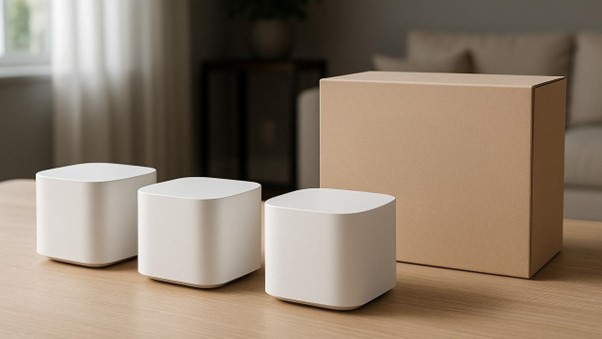
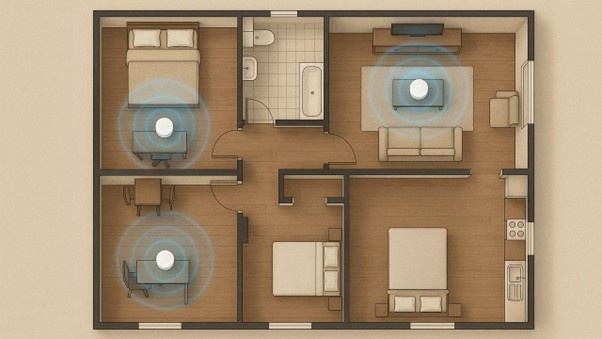
Who Actually Needs Mesh Wi-Fi?
Not everyone does. If you live in a small apartment or flat and get good signal in every room, you’re probably fine with a decent standalone router. But if any of the following apply, mesh is worth considering:
- Your home has more than one level
- You’ve got Wi-Fi dead zones (e.g. bedrooms, garage, outdoor areas)
- You have thick walls or an awkward layout
- You stream, game, or work from home in multiple rooms
- You’ve added a smart home setup with multiple connected devices
Mesh Wi-Fi is especially useful in homes over 120 square metres or with tricky layouts, places where standard routers struggle to provide reliable coverage.
How Does Mesh Wi-Fi Actually Work?
Each mesh node connects wirelessly to the others, creating a network that’s smarter and more dynamic than a traditional setup. If one path becomes congested or weak, the system reroutes traffic to keep your connection stable.
Modern systems use tri-band technology, which includes a dedicated backhaul band to let the nodes talk to each other without slowing down your devices. Some also support Ethernet backhaul if your home is already wired, giving you an even faster and more reliable setup.
What Features Should You Look For?
Here are a few things to consider when shopping:
- Tri-Band or Dual-Band: Tri-band models handle heavy traffic better.
- App-based setup: Most mesh systems come with mobile apps that walk you through installation and let you manage everything from your phone.
- Parental controls: Useful for setting limits on screen time or blocking specific sites.
- Guest network support: Easily share Wi-Fi without giving access to your main network.
Wi-Fi 6 or Wi-Fi 6E support: Future-proofing your setup with the latest standards means better speeds and more efficient performance.
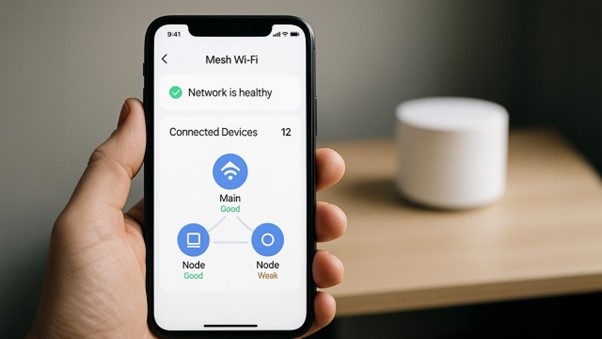
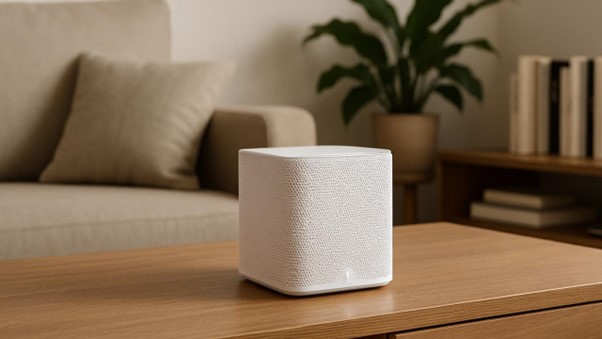
Does It Increase Internet Speed?
Not exactly, but it can make your Wi-Fi feel faster. Mesh doesn’t boost the speed coming into your home from your internet provider. What it does do is ensure that speed is delivered more consistently to every part of your home.
If your current router is underperforming due to range or interference, a mesh system can drastically improve performance, even if your internet plan stays the same.
Are There Any Downsides?
There are a few:
- Cost: Mesh systems typically start around NZD $300–$500 for a basic kit, and go higher for premium models with more features.
- Overkill for small spaces: If you live in a small home with no Wi-Fi issues, you won’t see much benefit.
- Complexity: Setup is simple, but there’s more going on under the hood compared to a single router.
That said, most users find the added reliability and range are worth the investment, especially if you’re fed up with constant buffering or signal dropouts.
Do I Need Mesh Wi-Fi?
Here’s a quick test:
- Do you lose signal when walking through your house?
- Do you have to switch networks when moving between rooms?
- Do streaming videos pause or degrade quality in some spots?
- Do smart devices lose connection in certain areas?
If you answered yes to any of these, mesh Wi-Fi might be the solution you didn’t know you needed.
Final Thoughts
Mesh Wi-Fi is no longer just for tech enthusiasts or luxury homes. It’s a practical upgrade for households that rely on stable, high-performance internet in every room. Whether you're working remotely, running a smart home, or just want to watch Netflix in bed without lag, a mesh system can make your internet experience faster, smoother, and less frustrating.
It won’t make your internet faster at the source, but it will make sure you get the most out of the connection you’re paying for, no matter where you are in the house.
Let me know if you'd like a shortened version for quick tips, or a buyer’s guide added to this.

